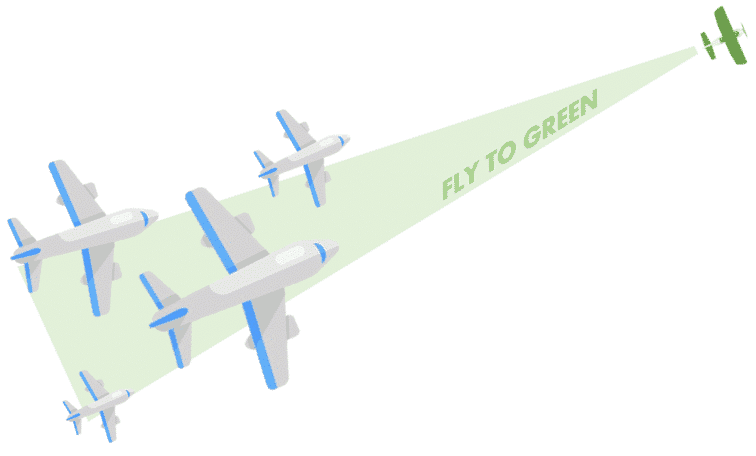Light aviation paves the way for low-carbon aviation
At the start of Q4 2023, in a context marked by inflation and the energy crisis, global air traffic is back to 97.1% of its pre-covid level. These figures confirm the momentum of the sector, which predicts a “back to normal”during 2024. However, this trend questions the commitments made by the International Civil Aviation Organization (ICAO). Last October, its General Assembly adopted carbon neutrality by 2050 as a climate objective, in line with the Paris Agreements, which aim to limit the global rise in temperatures to 2°C compared with the pre-industrial era. As a reminder, in 2018, CO2 emissions from civil aviation worldwide accounted for 2.6% of global emissions. Taking into account the radiative forcing effect4, this adds up to 5% of global emissions.
The ecological challenge for all players in the sector is therefore colossal. To compare, Airbus had announced a reduction in carbon footprint of 15 to 20% for the switch from an A320 to its modernised A320Neo version. Aircraft manufacturers urgently need to develop breakthrough technologies for new, less polluting aircraft.
In this race against time, the light aviation sector is in the front line, acting as a demonstrator for its big sister, commercial transport aviation. It is on these small aerobatic or tourist aircraft that the new technologies are tested, with the aim of decarbonising the sector before going to scale. In their sights is the famous certification, the holy grail for aircraft manufacturers, attesting to the safety of the aircraft and the final step before it is marketed.
Electric batteries, hydrogen and, in the shorter term, SAF (Sustainable Aviation Fuel) are emerging technologies that are shaping the new aircraft architectures of tomorrow. Here are a few of their characteristics.
1. THE HEART OF THE AIRCRAFT BEATS ELECTRICALLY
Batteries are a pillar of decarbonisation. They are already everywhere in our daily lives: in our computers, our phones, our cars… but what are the obstacles to their implementation in aeronautics? As pioneers, some players in light aviation are already well advanced, like the manufacturer Pipistrel whose Velis Electro, a two-seater designed for training, is the first electric aircraft in the world to have received certification from the EASA. We could also mention Aura Aero, aiming for certification within 1 to 2 years for its electric two-seater, Integral-E.
WHAT ARE THE SPECIAL FEATURES OF THE AEROSPACE INDUSTRY?
The requirements of the aviation sector are still not well expressed in relation to the automotive sector and are therefore poorly understood by battery manufacturers. The automotive sector has taken the lead and is financing massive investment worldwide , particularly in France. Here are a few constraints that are particularly important for the aerospace industry:
– SAFETY. This is the most important aspect of the aircraft manufacturers’ specifications in order to pass certification. The constraints of the aeronautics industry are strict, and there is no question of jeopardising the image of safety acquired by the sector in less than a century. Flammable components are particularly critical, and we need to look at all the potential hazards to guard against them: compartment ventilation to limit the spread of heat, fireproof partitions, missions in degraded mode, etc. Batteries using ‘ceramic’ or ‘all-solid’ technology are being studied to make them safer. In addition, batteries must be sufficiently robust to withstand crashes (e.g. test for resistance to 15 m- free falls).
– WEIGHT. Weight is one of the most important architectural parameters in the aeronautics industry. New lithium-based technologies could be used to replace heavy metals and thus gain in .
– ENERGY DENSITY. The energy density of batteries is a major lever. Today, it is still a long way from being equal to that of jet fuel. To give you an idea of the order of magnitude, jet fuel used to power aircraft engines is around 20 to 25 times more energy dense than a lithium battery. Magnesium or calcium are being considered to replace lithium and thus double the density of batteries. However, little progress has been made in this area in recent years, and hybrid powertrain architecture appears to be the recommended alternative: electric for short missions, hybrid for longer missions. Some are also opting to electrify the aircraft’s systems, and to develop the starter battery to save weight and maintenance.
– DURABILITY. The aerospace industry is aiming for 3,000 recharging cycles, whereas cars currently require “only” 1,000 to 1,500 recharging cycles.
– RECHARGING TIME. In light aviation, one of the major challenges facing aeroclubs is to maximise flight time in the face of downtime (battery recharging), for example during busy periods. By way of example, the Pipistrel Velis Electro advertises a recharging time of 2 hours to fly for around 45 minutes. This raises legitimate questions about the scalability of this solution, given that airlines do not spend more than 30 minutes on the ground between 2 flights.
– RANGE OF USE. The conditions of use are wider than for the car, typically for the operational temperature range with variations from -40°C to +50°C. At the same time, however, the optimum operating window for a current battery cell is restricted: below 5°C, it performs very poorly.
– NEED FOR VARIABLE POWER. Of course, ensuring power continuity is essential throughout the flight. However, we also need to be able to provide the power peaks required during certain phases, in particular take-off, which consumes much more energy than cruising flight.
– RECYCLING. The end-of-life and recycling of batteries is an emerging issue. We can imagine a second life and reuse for domestic applications requiring a much lower power density, such as powering household appliances. Dismantling batteries and retrofitting old batteries (replacing heavy metals) have a bright future ahead of them.

2. THE AIRCRAFT BREATHES HYDROGEN
The alternative to batteries may lie in dihydrogen technologies. A combination of societal and environmental factors is driving their development in the aeronautical sector: the ageing of the existing fleet (average age 30 years), the maturity of the technology, transport on land networks (roads, railways, waterways, etc.), compliance with the environmental constraints set by the ICAO, etc. The favourable context is being driven by a large amount of public and private funding.
Hydrogen is a very light chemical element, which makes it difficult to extract from its environment using primary energy. Hydrogen is described as “green” if the primary energy used to produce it is clean, and this gives rise to a colour code for categorising dihydrogen. At European level, regulations set the definition of “decarbonised dihydrogen” at 3 kg of CO2 per kg of dihydrogen. Unfortunately, most dihydrogen is currently produced for industrial needs by thermochemical processes based on fossil fuels.
Hydrogen can be used directly as a fuel (hydrogen aircraft), powering a combustion engine, or as an energy carrier via electrolysis in a fuel cell (electric aircraft). In the latter case, the hydrogen powers fuel cells and supplies electricity to electric motors for propulsion, eliminating the need for batteries.
CHALLENGES AND SPECIFICITIES FOR THE AERONAUTICS INDUSTRY
All the players are unanimous in saying that light aviation is the perfect playground for testing hydrogen architectures, before moving on to commercial aviation. Companies are betting on dihydrogen to power fuel cells, with different product architecture strategies: retrofitting existing products or complete new architectures (Beyond Aero, Blue Spirit Aero). Several demonstrators are expected by 2024, with the aim of passing the first certifications in 2026. Here are some of the major challenges.
– ARCHITECTURE. When it comes to building demonstrators and prototypes, there are two opposing philosophies:
- – Start from the classic jet fuel propulsion chain and adapt it to demonstrate the use of dihydrogen.
- – Start from scratch and design a completely new architecture to meet the specific needs of dihydrogen, from storage to the propulsion unit.
– STORAGE. Although dihydrogen has the advantage of being energy dense, a commercial transport aircraft will need it in large quantities. Furthermore, gaseous hydrogen occupies a very large volume at atmospheric temperature and pressure, so the dihydrogen storage solution is the key point, since it involves storage under high pressure. This is currently the solution used in the automotive industry (compression to 700 bars, i.e. 700 times atmospheric pressure). To further increase its density, one solution is to liquefy it by cooling it to -253°C. This is the process used to power the Ariane rocket engine. The dihydrogen has to be kept in a liquid state in cryogenic tanks, which consume a lot of energy. It is on this major point that the aerospace industry has the least experience. This has a direct impact on the architecture of the aircraft, as the size and shape of these tanks have to be defined.
– MATERIAL. Storing such a large volume of dihydrogen while maintaining it at such extreme temperatures requires the use of innovative materials to make up the cryogenic tank. The ideal candidate material must be perfectly watertight (to prevent leakage of the very light gas), thermally insulating and rigid to absorb shocks and pressure differentials.
– SAFETY. In the choice of design compromises around storage, the safety of the aircraft is a major issue with a view to certification, and then the transition to the series . Even if the debate remains open as to how dangerous the use of dihydrogen really is (in the case of aircraft), it will then be necessary to succeed in reassuring passengers.
– LOGISTICS. Finally, the entire logistics chain needs to be planned: from the production of dihydrogen using renewable energies to its transport to airports, liquefaction or compression, and rapid supply to aircraft, all while respecting the current operating costs of airlines .
3. THE AIRCRAFT RUNS ON BIOFUELS WITHOUT CHANGING ITS SKELETON
In 2016, Oslo became the first international airport to offer SAF . SAF or CDA, Sustainable Aviation Fuel, is the name given to alternative synthetic fuels certified as “sustainable” from a social, environmental and economic point of view. It is a “drop-in” fuel that can be mixed with jet fuel without modifying the architecture of current aircraft. These fuels are derived from sustainable raw materials, such as oils from waste and residues (used cooking oils, animal fats), agricultural and forestry residues, or carbon-rich gases. Currently, the standard allows up to 50% to be blended with aviation paraffin, but the industry is aiming for 100% by the end of the decade. SAF offers a number of advantages in the short term:
– Lower CO2 emissions than conventional paraffin
– Minor modification of the propulsion unit requiring minimal investment by airlines without fleet renewal
– Diversifying fuel supply sources
SAF is the “green” alternative that can be used right now to reduce CO2 emissions from the aviation sector. On the other hand, the growing volume demanded by this industry puts the use of arable land dedicated to this crop in competition with agriculture intended to feed people and livestock (for so-called first-generation fuels).
In brief
In the near future, light aviation will provide a demonstration ground for alternatives to paraffin. As far as batteries are concerned, the maturity brought about by the automotive sector has taken the first step, and will enable us to extend our needs to the specific requirements of the air transport industry. Limatech, a start-up based in the Haute-Garonne region, is aiming for certification of its lithium battery packs by 2024-2026, while new aircraft manufacturers, such as Voltaero and Ascendance Flight Technologies and Aura Aero from Toulouse, are focusing on hybrid propulsion architectures using batteries.
Dihydrogen is also the subject of numerous studies and prototypes with a view to its use in commercial aviation within the next 15 years. These include Beyond Aero, Blue Spirit Aero, H3 dynamics and Universal Hydrogen, all light aviation companies betting on dihydrogen. It should be noted that on this point, the transition to commercial scale will depend to a large extent on the ability to produce carbon-free hydrogen, powered by a wind or nuclear farm.
These two technologies offer hope of decarbonising the sector within 15 to 20 years. The first prototypes will be more expensive, and the cost of “CO2 hunting” could then be felt directly in the tickets sold by airlines.
The key players in the commercial sector are keeping a close eye on these transformations and advances to ensure they are keeping abreast of the latest trends. This is the case of European aircraft manufacturer Airbus, and its Airbus Developpement subsidiary, which has supported 1,500 companies over the past 25 years, including start-ups in the regions where it operates. This is the case of Blue Spirit Aero, working on a 100% dihydrogen 4-seater aircraft from 2026, which received an award last year from Airbus Developpement. Its American competitor offers the same support via the Boeing Startup programme.
Finally, it is essential to remember that the solutions presented above are based on technological innovations that are part of the airlines’ plans to renew their fleets and represent major investments for each of the players involved. If we are to achieve carbon neutrality by 2050, we will also need to take a wide-ranging look at the social implications of the transformation to the responsible, energy-efficient aviation of the future.
*Terrestrial radiative forcing : The white trails left in the sky by aircraft are called contrails and are the result of the meeting between the warm air from the jet engines and the cold, humid air at this altitude. “Persistent contrails and induced cirrus clouds accentuate global warming (especially cirrus clouds): they absorb part of the radiation from the Earth and re-emit it towards the ground, while being too fine to have an albedo effect that could counterbalance this warming. Although their impact is difficult to quantify precisely, it is generally estimated that this would double the radiative forcing of aviation”.
Source : https://www.carbone4.com/trainees-de-condensation-impact-climat & https://www.nature.com/articles/s41467-018-04068-0
Do you want to know more?
Find out more about our dedicated environmental performance offering and our expertise in the aeronautics industry!

